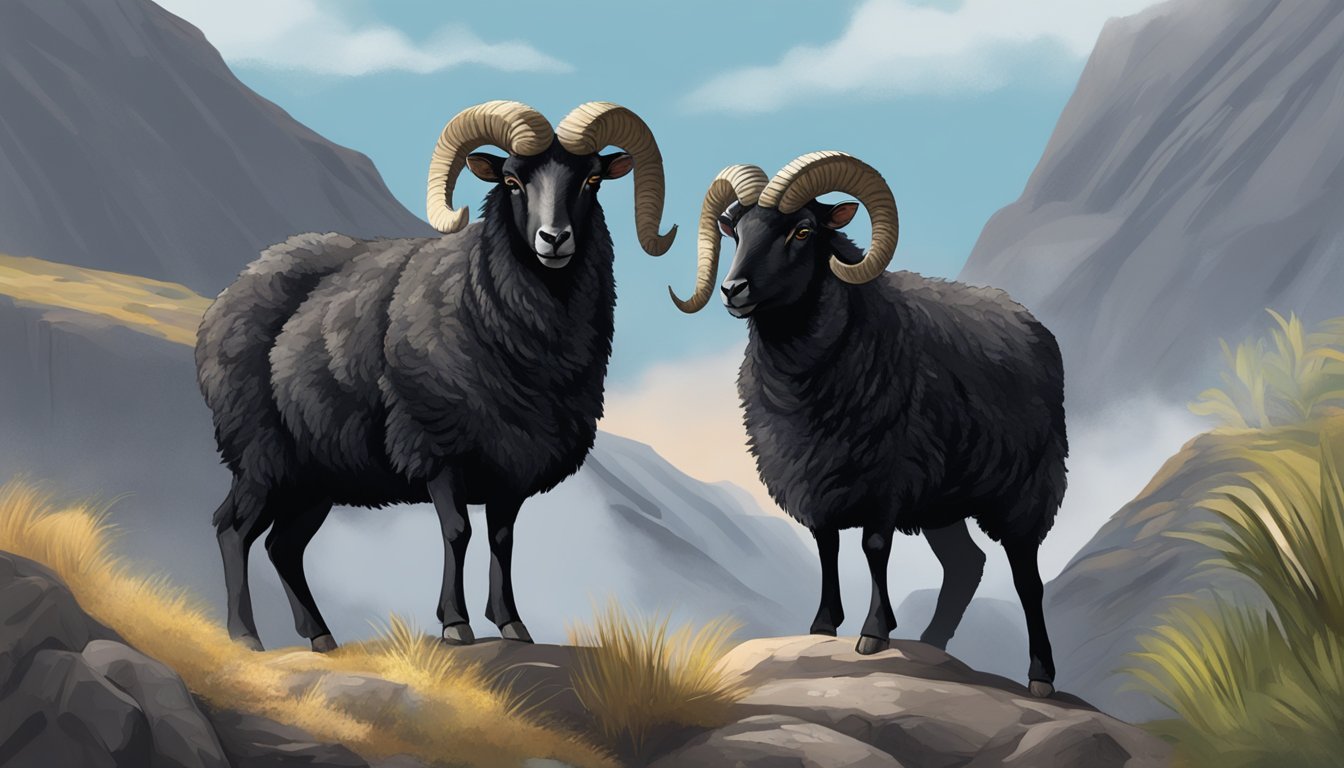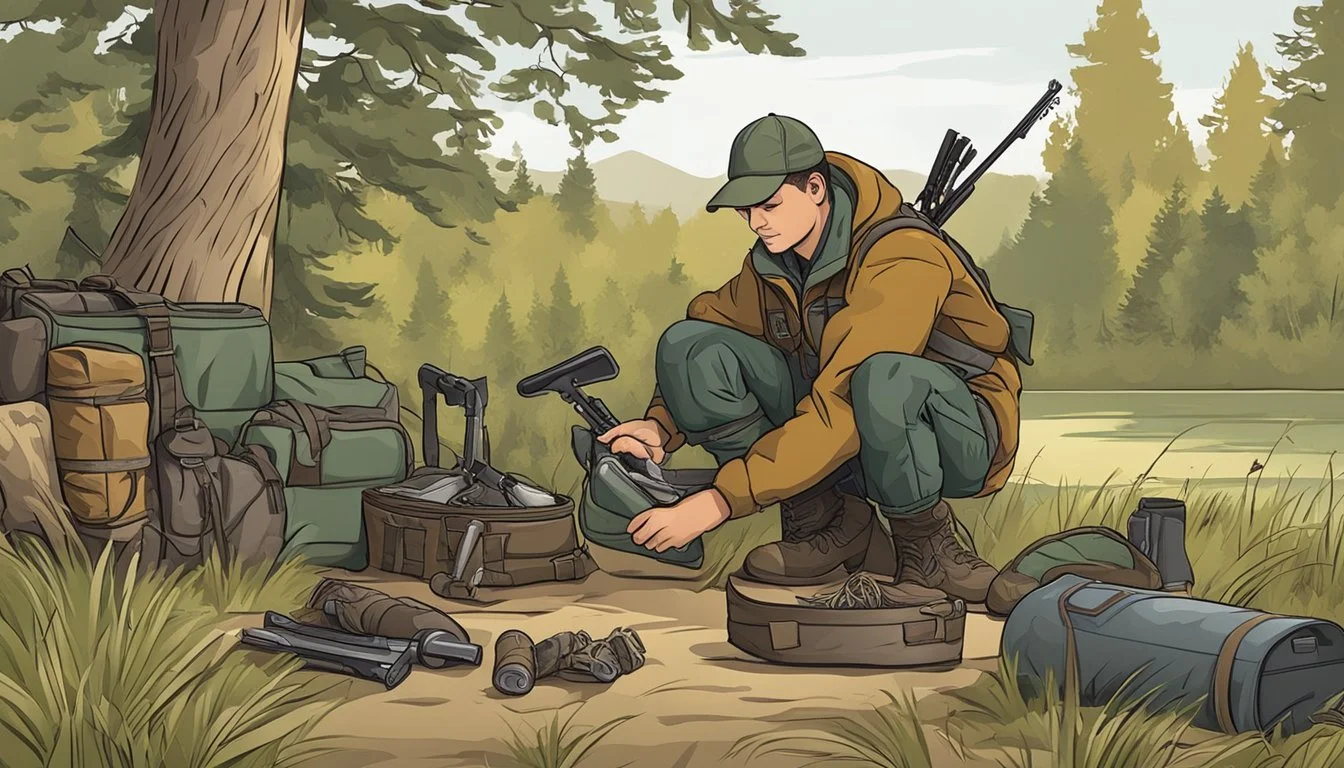Black Hawaiian Sheep Hunting Seasons
Guidelines and Timeframes
This Article is Part of Our Guide on Hunting Seasons for Over 70 Common Game Species
Black Hawaiian sheep are a unique game species, with origins tracing back to when Captain Vancouver introduced sheep to Hawaii in the late 1700s. These sheep are distinguished by their dark wool and the males are particularly notable for their impressive horn growth that often spirals in a corkscrew fashion. The Black Hawaiian sheep have adapted to a variety of climates and are known for their resilience and hardiness, traits that make them a desirable target for hunting enthusiasts.
When it comes to hunting Black Hawaiian sheep, the season is generally open year-round without any seasonal restrictions. This is due to their status as an exotic species in areas such as Texas, where they are not native, and therefore not subject to the same regulation as native game species. Their year-round availability allows hunters flexibility in scheduling their hunting trips, and the lack of seasonal restrictions caters to both resident hunters and those traveling from out of state.
The sustained interest in hunting Black Hawaiian sheep is reflected in the numerous ranches and hunting reserves that offer tailored experiences for those seeking to hunt this species. Hunters can choose from a range of landscapes and terrains, often with the opportunity to pursue record-setting trophies. The openness of the Black Hawaiian sheep hunting season contributes to the economic and conservation efforts by game ranches and preserves, ensuring populations are managed sustainably and ethically.
Understanding Black Hawaiian Sheep
Black Hawaiian Sheep are a unique trophy game species, revered for their sizable horns and adaptability. They possess distinctive physical traits and behaviors which make them a notable quarry for hunters.
Physical Characteristics
Black Hawaiian Sheep showcase a striking dark to black coloration, reflecting their name. The males are particularly noted for their impressive horns, which spiral in a corkscrew fashion. The size of these horns typically ranges from 28 to 38 inches. As for their build, these sheep generally weigh between 80 and 160 pounds, showcasing a robust and muscular physique.
Habitat and Range
Black Hawaiian Sheep have a broad range due to their adaptability. Originally from North America, they thrive in various environments and are not confined to a specific habitat. They have been successfully introduced to numerous ranches across Texas, where they have ample space to roam and sustain their populations.
Diet and Behavior
These sheep are herbivores with a diet consisting mainly of grasses, forbs, and similar vegetation. Their behavior is characterized by social grouping, often seen running in small bands. Dominance within these groups is established through head butting, a common trait among horned sheep species. Breeding usually peaks in late summer, with a gestation period of around six months, leading to most lambs being born in the early spring.
Hunting Techniques
The effectiveness of hunting Black Hawaiian sheep greatly depends on the method employed. Each technique offers unique advantages that cater to hunters' varying skills and preferences.
Spot and Stalk Method
In the Spot and Stalk technique, hunters meticulously search for sheep and then approach them stealthily on foot. The key to success lies in the ability to remain undetected while gradually closing in on the target.
Key Movements: Slow, deliberate, and quiet
Equipment Needed: Quality optics for spotting distant sheep
Bow Hunting Strategies
Bow Hunting demands precision and patience, utilizing archery equipment for a more challenging hunt. Hunters favor this method for its tradition and the skill required.
Preferred Distance: Closer range to increase accuracy
Gear Checklist: Compound bow, arrows, broadheads
Safari Style
Safari Style hunting mimics the classic African hunting experience, where hunters search for game from a vehicle before dismounting for the shot. This method offers mobility and a broad vantage point.
Ideal Terrain: Open areas suitable for driving
Hunt Transition: Vehicle pursuit followed by on-foot approach
Blind Hunting
Hunters using the Blind method stay concealed within a stationary hideout, waiting for the sheep to come into the effective range.
Blind Setup: Must offer a clear line of sight and camouflage
Waiting Game: Preparedness for long durations of inactivity
Regulations and Legal Considerations
When planning to hunt Black Hawaiian Sheep in Hawaii, it is essential to be well-versed with specific regulations that govern the hunting seasons, necessary licensing, and the legal equipment that can be used. These restrictions are in place to maintain both the health of the sheep populations and the safety of the hunting community.
Seasonal Restrictions
Hunters must adhere to the seasonal restrictions set by Hawaiian authorities, which define clear windows during which hunting Black Hawaiian Sheep is allowed. Hawaii's regulated seasons prevent overhunting and ensure sustainable management of sheep populations.
Black Hawaiian Sheep Hunting Season: The exact dates can vary each year, and one needs to consult the official Hawaii Department of Land and Natural Resources or similar resources for the current year's schedule.
Licensing and Permits
Each hunter is required to obtain a hunting license to legally pursue game in Hawaii. In addition, special permits may be required for hunting Black Hawaiian Sheep.
Hunting License: Typically needs to be valid for the current year and is mandatory for residents and non-residents.
Special Permits: Depending on the hunting region and the type of sheep hunt, additional permits may be necessary.
Legal Hunting Equipment
When hunting Black Hawaiian Sheep in Hawaii, the use of certain firearms and ammunition is stipulated by state regulations to ensure ethical hunting practices.
Rifles & Ammunition:
Only rifles of specified calibers and corresponding ammunition are authorized for sheep hunting.
The use of handguns may be restricted or forbidden.
Firearm Regulations: Hunters must comply with all state firearm regulations, including those pertaining to transport, use, and safety.
Preparation and Aftercare
Before heading out on a Black Hawaiian sheep hunt, hunters should ensure they are well-prepared and understand the steps required for aftercare post-hunt, including field dressing, meat processing, and managing trophies.
Gear and Provisions
Successful Black Hawaiian sheep hunting requires appropriate gear and provisions. Hunters should pack:
Camouflage Clothing: To blend in with the terrain.
Hunting Boots: Durable and able to handle rough terrain.
Rifles/Bows: Chosen based on the preferred hunting method.
Optics: For spotting sheep at a distance.
Navigation Tools: GPS or a compass for orientation.
Field Dressing Kit: Sharp knives, game bags, and gloves.
As for provisions, bring sufficient water, snacks, and meals to maintain energy throughout the hunt.
Field Dressing and Meat Processing
Immediately after a successful hunt, field dressing is imperative to preserve the meat. The hunter should:
Cool the carcass: To prevent spoilage.
Skin and eviscerate: Partially, to prepare it for transport to a meat processor.
When the hunt concludes, the hunter should bring the carcass to a professional meat processor to:
Inspect: Ensuring the meat is safe for consumption.
Process: Turning the carcass into various cuts for meals.
Package: For ease of
Hunt Planning and Lodging Options
When planning a Black Hawaiian Sheep hunting trip, hunters must consider their guide or outfitter options and what type of lodging and facilities are available. The goal is to ensure a successful and enjoyable hunting experience with all necessary amenities covered.
Choosing a Guide or Outfitter
Prospective hunters should prioritize selecting a guide or outfitter with expertise in Black Hawaiian Sheep hunting. It's advisable to check for a guide's availability well in advance, as spots can fill up quickly. Outfitters typically offer different packages, including guide fees, which can vary. A deposit may be required upon reservation to secure one's spot. Hunters can often contact the outfitter via email or phone to discuss specific needs, and should inquire whether the outfitter offers any opportunity guarantee — a policy that may offer hunters another opportunity if they do not succeed.
Accommodations and Facilities
Accommodations can range from rustic campsites to luxurious lodges. Lodges often provide comfortable rooms and include amenities like meals, which are essential for hunters to start off their day. Hunters should verify the types of rooms available and whether there is the option to accommodate non-hunting guests for an additional fee. The availability of transportation to and from hunting sites is also a logistical point to clarify. Hunters can generally request more information or complete a reservation via the outfitter's contact us page or provided email address. Facilities for storing gear, as well as places to relax after the hunt, are typically part of the accommodation offerings.
Conservation and Population Management
In managing Black Hawaiian Sheep, sustainable hunting practices and careful population control are critical elements to balance both the ecosystem and hunting opportunities.
Importance of Sustainable Hunting
Sustainable hunting refers to regulated hunting that maintains the species' populations at healthy levels, ensuring that their numbers do not decline over time. For Black Hawaiian Sheep, which include a blend of Mouflon Sheep, Corsican Sheep, Texas Dall Sheep, and other hybrid sheep varieties, regulatory measures are necessary to prevent overhunting. Authorities monitor population levels and adjust hunting seasons and quotas to align with conservation goals. These measures ensure not only the survival of the species but also the continuation of hunting traditions.
Population Control
Population control of Black Hawaiian Sheep is a deliberate strategy to maintain not only the species' health but also the health of the ecosystem. Overpopulation can lead to ecological imbalances, where these sheep may overgraze and damage the habitat they and other species depend on. Controlled hunting seasons, especially for species like Mouflon Sheep and its hybrids, help to manage these populations. The goal is to keep the population within the carrying capacity of their environment, thus promoting a balanced and sustainable ecosystem.
Additional Activities and Services
Beyond the pursuit of Black Hawaiian Sheep, hunting ranches typically offer a variety of recreational activities and guest services to enhance the experience.
Fishing and Recreation
Fishing: Many ranches boast well-stocked ponds or access to river fishing, providing a relaxing complement to hunting. Anglers can often target a range of species, including bass and trout, depending on the ranch's locale.
Recreation: For non-hunting hours, guests might find hiking trails or admire local wildlife and scenery. Some ranches may feature a gallery showcasing the property's history or notable catches.
Guest Services and Facilities
Accommodations: Lodging options range from rustic cabins to luxurious suites, designed to meet the needs of solo travelers, families, and large groups.
Amenities: Conveniences such as on-site dining, Wi-Fi, and guided services are typically available. Visitors are encouraged to contact the ranch ahead of time, possibly via a contact form on the ranch's website, to inquire about specific services and to book facilities.
Hawaiian Hunting Culture and History
Hawaiian hunting traditions encompass a rich history, marked by the introduction of various species and the cultural significance held by the practice of hunting on the islands.
Origins of Sheep Hunting in Hawaii
Sheep were not native to Hawaii; they were introduced in the late 1700s by Captain George Vancouver. Among the species introduced were the ancestors of the Black Hawaiian ram, believed to be a cross between the mouflon—a wild sheep native to the Middle East and thought to be one of the two ancestors for all modern domestic sheep breeds—and black-haired sheep from Hawaii. This interbreeding led to the resilient Black Hawaiian sheep, which thrived on the volcanic slopes of Mauna Kea and Mauna Loa. With no natural predators and ample terrain provided by the volcanic landscapes, sheep hunting became a significant activity on the islands.
Cultural Significance
Hunting in Hawaii has always held cultural importance, linking to subsistence, sport, and the maintenance of ecological balance. The introduction of species like the mouflon and subsequent hybrids, which fall into the Corsican ram family, has embedded sheep hunting into the fabric of island life. The practice not only provides food but also connects hunters to the land and to the traditions of the past. Volcanoes have shaped the terrain, creating challenging hunting grounds that require skill and respect for the environment, echoing the hunters' deep-rooted connection with the land.
Hawaiian hunting culture is a testament to the adaptation of society to its environment, showcasing the enduring bond between the people and their dynamic, volcanic landscape.









